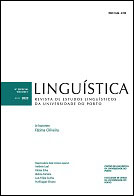On Evidentiality and Perception: Ambivalent adjectives in the Spanish non-finite complements of ver
Abstract
In this paper, I will pay attention to the behavior of adjectives such as altísimo and torpe, called ambivalent (Luján 1981) or underspecified (Fernández Leborans 1995), due to the fact that they can be combined with both the copulative verb ser and the copulative verb estar in languages such as Spanish. More specifically, I am interested in two structures, both of them dependent on the Spanish verb of perception ver. In the first, altísimo and torpe combine with the copula estar in infinitive clauses. In the second, subordinate infinitive clauses are headed by the copula ser. I will try to elucidate which is the contribution of the copulative verbs to the interpretation of these structures. With Escandell-Vidal (2018), I assume that the adjectives altísimo and torpe in combination with estar give rise to an evidential effect: the spatio-temporal situation to which the property they denote is anchored is conceived as a situation of visual experience. In the first of the structures I am interested in, the source of information is likewise encoded in the verb of perception. Therefore, the research question that will guide this study is whether the evidential content is actually being expressed twice.
References
Aikhenvald, A. Y. (2004). Evidentiality. Oxford University Press.
Anderson, S. R. (1971). On the role of deep structure in semantic representation. Foundations of Language, 6, 197-219.
Arche, M. J. (2006). Individuals in Time: Tense, Aspect and the Individual/Stage Distinction. John Benjamins.
Arche, M. J. (2011). Las oraciones copulativas agentivas. In V. Escandell-Vidal, M. Leonetti, & C. Sánchez López (Eds.), 60 problemas de gramática dedicados a Ignacio Bosque (pp. 99-105). Akal.
Brucart, J. M. (2010). La alternancia ser/estar y las construcciones atributivas de localización. In A. Avellana (Comp.). Actas del V Encuentro de Gramática Generativa (pp. 115-152). Editorial Universitaria del Comahue.
Carlson, G. N. (1977). Reference to kinds in English [PhD Dissertation]. University of Massachusetts.
Carrasco Gutiérrez, Á. (2017). ¿Estados progresivos? Moenia, 23, 67-417.
Carrasco Gutiérrez, Á. (2018). What is complex in verla hacer algo. In B. Sanromán Vilas (Ed.), Semi-lexicality: Studies on light verbs, periphrases, and other constructions (Mémoires de la Société Néophilologique de Helsinki) (Tome CIII, pp. 83-120). Société Néophilologique de Helsinki.
Carrasco Gutiérrez, Á., & González Rodríguez, R. (2011). La percepción visual de estados. In Á. Carrasco Gutiérrez (Ed.), Sobre estados y estatividad (pp. 158-188). Lincom Europa.
Clements, J. C. (1988). The semantics and pragmatics of Spanish construction. Linguistics, 26(5), 779-822.
De Villiers, J., & Garfield, J. L. (2017). What do children learn when they learn about evidentiality. In F. N. Ketrez, A. C. Küntay, S. Özçalışkan, & A. Özyürek (Eds.), Social environment and cognition in language development: Studies in honor of Ayhan
Aksu-Koç (pp. 113-132). John Benjamins.
Deo, A., Sánchez-Alonso, S., & Piñango, M. (2017). Alternative circumstances of evaluation and the ser/estar distinction in Spanish [Master’s Thesis]. Yale University.
Dretske, F. (1969). Seeing and knowing. University of Chicago Press.
Escandell-Vidal, M. V. (2018). Ser y estar con adjetivos. Afinidad y desajuste de rasgos. Revista de la Sociedad Española de Lingüística, 48, 57-114.
Escandell-Vidal, M. V., & Leonetti, M. (2002). Coercion and the Stage/Individual distinction. In J. Gutiérrez-Rexach (Eds.), From words to discourse: Trends in Spanish semantics and pragmatics (pp. 159-179). Elsevier.
Fábregas, A., Leferman, B., & Marín, R. (2013). Evaluative adjectives are Davidsonian states. Proceedings of Sinn und Bedeutung, 17, 237-253.
Fernández Leborans, M. J. (1995). Las construcciones con el verbo estar: aspectos sintácticos y semánticos. Verba, 22, 253-284.
Gallego, Á., & Uriagereka, J. (2009, april 1-3). Estar = Ser + P. [Oral Presentation]. XIX Colloquium on Generative Grammar. Vitoria-Gasteiz: University of the Basque Country, Basque Country.
Gruber, J. (1965). Studies in lexical relations. MIT Press.
Jackendoff, R. S. (1990). The antisymmetry of syntax. MIT Press.
Kalsang, J. G., Speas, M., & de Villiers, J. (2013). Direct evidentials, case, tense and aspect in Tibetan: evidence for a general theory of the semantics of evidentials. Natural Language and Linguistic Theory, 31(2), 517-561.
Klein, W. (1994). Time in language. Routledge.
Leferman, B. (2017). Evaluative adjectives as a window onto inner aspect [PhD Dissertation]. University of the Basque Country.
Leonetti, M., & Escribano, G. (2018). El papel del aspecto gramatical en las construcciones con estar. Revista de la Sociedad Española de Lingüística, 48(1), 115-152.
Luján, M. (1981). The Spanish copulas as aspectual indicators. Lingua, 54(2-3), 165-210.
Lyons, J. (1977). Semantics. Cambridge University Press.
Maienborn, C. (2005). A discourse-based account of Spanish ser/estar. Linguistics, 43(1), 155-180.
Mangialavori. M. E. (2013a). Not always a stage. Atypical patterns in Spanish copular clauses. Iberia, 5(2), 1-37.
Mangialavori. M. E. (2013b). Conciliating states and locations: Towards a more comprehensive and in-depth account of the Spanish copula estar. Studies in Hispanic and Lusophone Linguistics, 6(1), 37-78.
Marín, R. (2010). Spanish adjectives within bounds. In P. Cabredo Hofherr, & O. Matushansky, (Eds.), Formal analyses in Syntax and Semantics (pp. 307-322). John Benjamins.
Martin, F. (2006). Prédicats statifs, causatifs et résultatifs en discurs. Sémantique des adjectifs évaluatifs et des verbes psychologiques [PhD Dissertation]. Université Libre de Bruxelles.
Mateu, J. (2002). Argument structure: Relational construal at the syntax-semantics interface [PhD Dissertation]. Autonomous University of Barcelona.
Moreno Cabrera, J. C. (2003). Semántica y gramática. Sucesos, papeles semánticos y relaciones sintácticas. Antonio Machado Libros.
Reichenbach, H. (1947). Elements of symbolic logic. MacMillan.
Speas, M. (2008). On the syntax and semantics of evidentials. Language and Linguistics Compass, 2(5), 940-965.
Speas, M. (2010). Evidentials as Generalized Functional Heads. In A. M. Di Sciullo, & V. Hill (Eds.), Edges, heads and projections: Interface properties (pp. 127-150). John Benjamins.
Downloads
Published
Issue
Section
License
Copyright (c) 2022 Linguística: Revista de Estudos Linguísticos da Universidade do Porto

This work is licensed under a Creative Commons Attribution-NonCommercial 4.0 International License.



